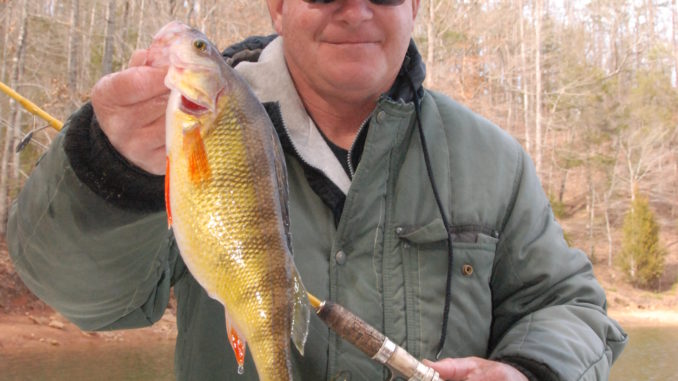
Call them coon-tails or Eisenhowers, yellow perch are one of the tastiest and most overlooked fish in South Carolina — but around Lake Russell, they’re a favorite fishing target.
Of the dozen or so major reservoirs in South Carolina, the baby and beauty of the group is Lake Richard B. Russell.
Nestled on the Savannah River between Lake Hartwell and Clarks Hill, Russell reached full pool of 26,650 acres in December 1984. One of Russell’s selling points for sportsmen is that federal regulations prevent any private residential development along its shoreline; the result is a wilderness experience akin to fishing a remote Canadian lake in the heart of Dixie.
Not only does the scenery suggest such a locale, if you hold your fishing rod in the right location and manner, you’re likely to catch fish that would seem more at home in the Yukon than on the border between Georgia and South Carolina, and that just makes fishing guide Wendell Wilson smile.
“I had some clients from up north who used to spend a week every year fishing in Canada for yellow perch,” Wilson said. “By chance, they booked a trip with me and discovered Lake Russell; that same day, we caught a big mess of yellow perch, and they couldn’t believe it. They said not only was the scenery the same, it was not nearly as cold — and the yellow perch they caught here were a lot bigger.”
The native range of the yellow perch is centered in the upper Midwest and Canada, but fish are found as far south as Georgia. When Lake Russell was created, the species was native to the upper Savannah River reaches of Clarks Hill and flourished in both lakes.
Somehow, the species wound up being dubbed by local anglers as Eisenhower Perch after the 34th president. According to Wilson, who has guided on Russell and Clarks Hill for the past 22 years, the heyday of yellow perch fishing in Russell peaked several years ago.
“Back in the early ’90s, it was easier to catch yellow perch than it is now because there weren’t as many white perch in the lake,” Wilson said. “Once you got on any kind of perch pattern, your percentage of large yellow perch was a lot better back then than it is now.”
Wilson makes this statement as more of an observation than complaint, because at the end of the day his clients are actually seeing just as many, if not more, fish in the livewell — they’re just perch of a different color.
Wilson said white perch populations in both Russell and Clarks Hill began mushrooming around 2000, and as far as he’s concerned, he doesn’t fish for the two species any differently.
“It’s really hard to just target yellow perch now, because you’re going to catch yellow perch, white perch, crappie and spotted bass in the same places,” he said. “The fish move out to deeper water in late November, and they’re pretty predictable all through December and January and most of February. As soon as it warms up, whether late February or early March, they scatter, head back toward the banks and are harder to catch in any number.”
The pattern for finding and catching yellow perch on Lake Russell is pretty simple. Russell is known for it’s vast acres of standing timber and stump fields.
Wilson targets everywhere else, so long as the water depth is at least 30 feet.
“In Russell, the ideal depth is 30 to 40 feet, but you have the underwater timber when you get deeper than 40 because it wasn’t cleared beyond that level,” he said. “If you can find an area that used to be an old pasture, you can catch them down to even 50 or 60 feet deep.
“One of the best places to find this kind of bottom is about half way up any of the larger creeks. It’s going to be about 40 feet deep on the flats near the creek channel. Other than that, you can look out off the main Savannah River channel, and you’ll find some deep water flats there.”
Another fisherman who shares Wilson’s passion for Lake Russell cold-water perch jerking is James McSwain of Campobellow, who owns a cabin in Lowndesville and spends many winter mornings on Russell fishing for perch. He believes yellow perch show more of a preference for deep water than most other species.
“The best place I’ve found to catch big yellow perch is in 60 to 70 feet of water, right off the bottom on a deepwater flat,” said McSwain. “When I’ve found the big yellow perch, there doesn’t seem to be as many white perch, crappie or spotted bass with them.”
McSwain offered as one of his favorite yellow perch locations an area known as the “Blue Hole” below Calhoun Falls State Park near the intersection of the Savannah River and Rocky River. He also has a favorite time of day.
“We do better from daylight until about 10 or 11 a.m.,” he said. “After that, the bite just shuts off.”
Wilson and McSwain agreed on their approach to catching yellow perch. Both prefer live, medium-sized minnows fished vertically on light tackle using a single or double No. 2 or No. 4 light-wire gold hook on 6-pound-test line.
“I might start out with two rods and set them in a rod holder, but once you get into the fish, you can’t fish but one rod. The action will be that fast,” McSwain said.
Before either decides to deploy rods, they make sure they’re in an area holding fish. Their approaches to deciding when to fish such areas differ, however.
“If I don’t see any bait — any shad — down deep, then I’m probably not going to fish there,” Wilson said. “As long as the bait is more than halfway down to the bottom — let’s say I’m looking at 40 feet of water, and the bait is at least below 20 feet — that’s fine. I’ll stop and fish if I see enough bait, even without seeing any fish.”
McSwain said seeing bait on his graph isn’t enough.
“I’m going to mark fish before we set down,” said McSwain. “It’s pretty common to see bait piled up in a lot of deep holes in the winter. You need to be able to see fish in there with them, or you’d be better off moving on and checking out another spot.”
Though white perch and yellow perch are technically unrelated, they do share one major characteristic that might explain why no one makes an issue about the color of perch coming over the gunwale. Both fish put up a pretty scrappy fight and are second to none on the plate.
“I love to eat both of them,” Wilson said.
“You take a big white or yellow perch that will go a pound or a pound-and-a-half and filet him — it’s one of the best-eating fish you’ll find,” McSwain said.
It was President Dwight D. Eisenhower, in a speech to the Republican national committee in January 1958 who said, “What counts is not necessarily the size of the dog in the fight — it’s the size of the fight in the dog.”
Maybe that’s why somebody named a perch after him.
DESTINATION INFORMATION
WHEN TO GO — Yellow and white perch in Lake Russell crappie will move to their wintertime hang-outs in mid-November and stay until the water temperature starts to warm in late February. The best fishing times are from daylight until about 11 a.m.
HOW TO GET THERE — The best access to Lake Russell is from a series of public ramps off SC 81 near Calhoun Falls: Millwood, Calhoun Falls State Park, Beer Garden Creek, Blue Hole and Latimer. The Felker, WIlson Creek and Allen Creek ramps are near Lowndesville, off CR 64, CR 72 and CR 70, respectively.
LOCATION/TECHNIQUES — Lake Russell perch can be found on clean bottoms, holding on deep-water flats in the mid-lake area ranging from 30 feet to as deep as 70 feet. The best locations are wide areas about halfway up large tributaries, the mouths of large coves entering the main lake, and old flooded pastureland adjacent to the Savannah River and Rocky River channels. A tight-line presentation of live minnows works well. Once you have located a suitable flat were baitfish or perch are holding, use a 1- or 2-hook rig to suspend the bait about a foot off the bottom. Once a school of perch is located, expect the action to be fast and furious until the school moves off. You can either wait for the school to return or leave in search of another school.
RULES/REGULATIONS — The daily creel limit for yellow perch is 30 fish. White perch are not managed with a creel limit.
GUIDES/FISHING INFO — Wendell Wilson, Wilson’s Guide Service, 706-283-3336or, www.wilsonsguideservice.com; Sportsman’s One Stop, 9807 South Highway 81, Iva, 864-348-2840. See also Guides & Charters in Classifieds.
ACCOMMODATIONS — Calhoun Falls Chamber of Commerce, Calhoun Falls, 864-418-8672.
MAPS — Kingfisher Maps, Clemson, 800-326-0257 or www.kfmaps.com; Delorme South Carolina Atlas & Gazetteer, 800-561-5105 www.delorme.com.

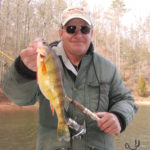
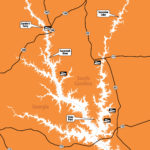
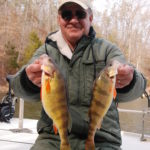
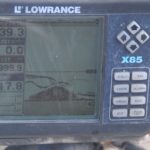
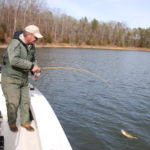

Be the first to comment